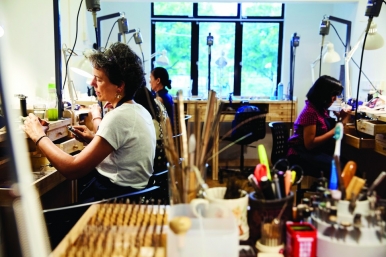Southeast Asia is fast becoming a lucrative destination for professional gemologists and hobbyists learning the ropes


“If it doesn't sparkle, I'm not interested,” says gemologist and jeweller Lucy Walker with a cheeky glint in her eye. The British expat is talking gemstones with me from her studio in the affluent neighbourhood of Bangsar in Kuala Lumpur, and it's crystal clear that this is her favourite topic of conversation.
“Diamonds, rubies, emeralds and sapphires are obviously the big four of precious stones,” she explains, “and they're found in abundance across Asia. But there are others which are just as beautiful like spinel and watermelon tourmaline, which is my personal favourite. They're not as well known but the colours are incredible and they make stunning pieces of jewellery.”
Walker settled in Kuala Lumpur three years ago, having lived in Australia, New York and the Philippines; Manila is where she first began her education in gemology a decade ago.
In November 2017 she made two major commitments to Malaysia by marrying a local and opening a jewellery design studio and academy in Bangsar. From here, she creates commissioned pieces for clients, and this year, she's rolling out a curriculum of courses in gemology, aimed at arming those with ambitions of buying gemstones on their travels with the knowledge to make sound purchases.
“I can't teach gemology in one course; it's something that takes years of study, but I can teach people how to make more informed decisions when buying stones here,” she says. “There's understanding the basics of the four-Cs: carat weight, clarity, cut and colour, but then there's also understanding where to be flexible on these to get the best out of your budget.”
“With stones like rubies, sapphires and emeralds, there are preferred market colours. This is fantastic for buyers on a budget because you can get cheaper stones, for example, by looking at rubies, which have an orange tone, or sapphires that are more greenish-blue than brilliant-blue. They are just as beautiful. You can also look at different cuts. There are lots of ways to make your money go further.”

Walker has been buying stones overseas on behalf of clients for years and believes looking like a pro will stand you in good stead to negotiate the best price for your bounty. “There's a lot to be said for simply being able to handle basic tools like a loupe and tweezers, using the right language and asking smart questions. You'll look less of a novice in front of a seller,” she explains.
Walker's courses will also teach students the basics of spotting real stones from fake ones.

“If the colour is bright and it's cheap, it's probably not real, and if the proportions of the stone are absolutely perfect, it's also unlikely to be real because gemstones are cut to retain as much weight as possible, not to be in perfect proportion.” she says. “Common imposters to look out for are glass, which you can tell because it's softer, therefore nowhere near as sparkly as a precious stone, and cubic zirconia, which actually sparkles too much. When you know what you're looking for, it's easy to spot those fakes. Glass also warms quicker against skin than a gemstone will, which is a good test.”
But, she says, the harder nuances to detect come in the form of treated or synthetic stones. “Treated stones are big business in this part of the world, especially in places like Bangkok where they're very good at it. Treating stones can make them more durable, brighter in colour, and it can make a less-than-perfect stone look better, by filling imperfections with glass or resin, in order to sell it at a higher price,” she explains. “The problem is that, while it looks perfect, the stone is technically worthless and you can spot that by learning how to see the lustre difference between the surfaces.”

That said, Walker is adamant that Southeast Asia is one of the best places in the world to explore gemology and buy stones. “There's so much choice in gemstones all over Asia. It's a real playground for people who are interested in the subject or just love a bit of sparkle. Gemstones can have great stories behind them, memories from trips taken, and that's a really special thing to turn into a piece of jewellery,” she says. “But it's worth understanding the basics before you go shopping.”
“Always haggle,” she advises. “But before you do, ask around. If you want an amethyst for example, go somewhere like Bangkok, where you'll find hundreds of them. Then look for the kind of stones you like, the shape and colour and size, and ask the price. If you ask enough people, you'll soon get a realistic idea of what you're going to have to pay for that sort of stone. Then try and get 20 percent off.”

“Do your research to find out the best place to buy stones before you arrive,” she continues. “Never go anywhere with a tuk-tuk driver; nine times out of ten it won't be reputable or fairly priced.”
But most importantly, says Walker, make sure you have fun. “One of the best things you can do is set yourself a budget of USD100 (RM390) and take yourself on a treasure hunt. Have fun with it, shop around, haggle and buy a few stones you love the look of,” she says. “Then, bring them home and take them to a gemologist or a jeweller and see if they're real. If they are, maybe you've got an eye for it. If they're not, the USD100 (RM390) was still money well spent because you'll have learned a lot, you enjoyed it and you got something shiny out of it.”
Lucy's Gemology for Travellers class will run regularly throughout 2018 alongside her contemporary jewellery design courses. She also takes commissions for pieces and will be launching her own line of jewellery later in 2018. lucywalkerjewellery.com









